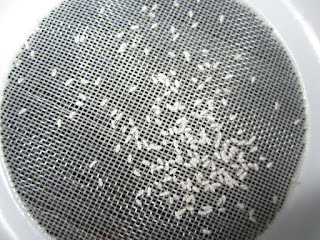
If you have a lot of insectivorous reptiles and amphibians then chances are you have to buy a lot of crickets. Or maybe you already breed them yourself. If you do, read no further. if you don't, why don't you? If a1l you need is 20 crickets a week breeding them won't be worth it (but it will still be fun). If on the other hand you need 100 or more crickets a week then you should definitely look into breeding your own. Be warned, though, crickets smell and they chirp. So find a place not near your sleeping area to store your colony.
Sexing Crickets
You will need adult crickets to begin your colony. Adult crickets are about an inch long and have fully developed wings covering the abdomen. Males have 2 appendages sticking out of the end of the abdomen. Females have three. The middle one on the females is long and black and is called the ovipositor. It is from here that they lay their eggs.
How Many Crickets Do I Need?
Not as many as you might think. A female cricket lays about 5-10 eggs a day, for a total of around 100 in her life (this does not mean the only live 10-20 days just that they will lay up until they reach 100 give or take). So 10 females should give you 1000 baby crickets if you let them lay for 10 days right? Well some females will inevitably die and some may be more or less prolific (not to mention some eggs might not hatch and some babies will die also) Basically the longer you let the females lay eggs the more baby crickets you will get. I recommend starting off small. Go to a pet shop and ask for 20-30 large crickets. You should get a good mix of males and females to start with. Make sure they are adults, though. Not all crickets sold as large may be adults (look for fully developed wings- if you can see the abdomen the wings are not fully developed).
The Setup
A glass tank or critter keeper is good for a small colony. Provide the crickets with food, water, heat, something to crawl on, and a place to lay eggs. Food can include store bought gutload, cricket gels, chicken mash, fruits and vegetables, and oatmeal. Water can come from the foods if they are well like fruits, wet paper towels, or a shallow dish of water with cotton swabs on them. Heat can come from a heat lamp, heating pad or placing the cage next to a radiator. Crickets like it between 85-88 degrees F. Toilet paper tubes and egg carton (paper) will give them climbing surfaces. The egg laying container can be any old plastic container filled with moist coco fiber or other clean soil. Keep it moist not wet. I use old margarine tubs. Clear containers are nice also because you can see the eggs around the edge.
The Babies
Remember that the females will lay 5- 10 eggs a day. The average of that is 7. If you have 15 females, in 3 days you will have around 315 eggs (I you do not heat the crickets you will have significantly less). I would remove the egg laying container at this point, since you don't want to many for you first time. Put the container in another heated cage. Keep it moist! The eggs will hatch in 10-14 days. The young are called pinheads because they are very small. If you have small animals you may use them now. If not you will have to raise them. The young eat what the adults eat, but I would chop it smaller for them. Crickets go through eight sizes. How fast they grow depends on temperature, but in a few weeks they should be standard pet shop "small" size.
Conclusion
Breeding Crickets can be a fun and rewarding experience. It is not all that difficult either. It is so easy. I did it by accident many yrs ago. I was feeding my toad Ben large crickets (the pet shop was out of small). As usual I poured the crickets directly into the cage. Ben ate greedily but missed a few. "He'll get those later" I said. Sure enough he got them. well two weeks went by. I look into his cage and what do i see?. An area of soil covered with little white dots. My first thought was "springtails! why are they swarming?" But upon closer examination I noticed they were baby crickets hatching and I wasn't even trying!
You can buy crickets from many places including Amazon using the link below.








